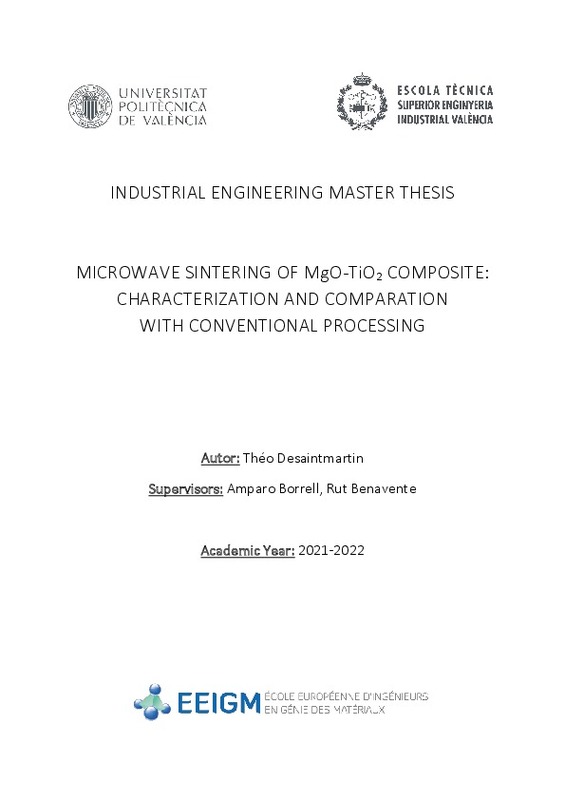JavaScript is disabled for your browser. Some features of this site may not work without it.
Buscar en RiuNet
Listar
Mi cuenta
Estadísticas
Ayuda RiuNet
Admin. UPV
SINTERIZACIÓN POR MICROONDAS DEL COMPOSITE MgO-TiO2: CARACTERIZACIÓN Y COMPARACIÓN CON EL PROCESAMIENTO CONVENCIONAL
Mostrar el registro sencillo del ítem
Ficheros en el ítem
| dc.contributor.advisor | Benavente Martínez, Rut
|
es_ES |
| dc.contributor.advisor | Borrell Tomás, María Amparo
|
es_ES |
| dc.contributor.author | Desaintmartin, Théo
|
es_ES |
| dc.date.accessioned | 2022-02-11T19:35:01Z | |
| dc.date.available | 2022-02-11T19:35:01Z | |
| dc.date.created | 2022-01-27 | |
| dc.date.issued | 2022-02-11 | es_ES |
| dc.identifier.uri | http://hdl.handle.net/10251/180765 | |
| dc.description.abstract | [ES] La sinterización por microondas se ha convertido en una técnica potencialmente prometedora de bajo consumo energético para la investigación en ciencia de los materiales. Basada en la interacción de las microondas con la materia, ofrece posibilidades ilimitadas para una rápida síntesis y sinterización de cerámicas micro y nanoestructurados. Hay dos razones principales por las que la consolidación de materiales por microondas permite mejorar las propiedades finales de estos, especialmente en el caso de los nanopolvos cerámicos; al tratarse de una técnica de calentamiento rápido - controla el crecimiento del tamaño de grano y la homogeneidad de la microestructura - lo cual difiere mucho de otros tipos de sinterizado. Por lo tanto, esta técnica abre la posibilidad de conseguir materiales cerámicos avanzados con una combinación de propiedades estructurales y funcionales excepcionales adaptadas en todo momento a un mercado tecnológico cada vez más sofisticado. En este trabajo se compararán los diferentes procesos de sinterización, convencional y no-convencional, de materiales compuesto de MgO-TiO2. En cuanto al método de microondas, se estudiará la influencia del campo eléctrico y los parámetros de calentamiento: como es la rampa de calentamiento/enfriamiento, temperatura final, tiempo de permanencia, potencia aplicada y propiedades dieléctricas vs. temperatura. Una vez obtenidos los materiales densificados, se procederá a estudiar sus propiedades finales para poder determinar su aplicación tecnológica. Para ello, se determinará la densidad mediante el método de Arquímedes, (estudiando la porosidad interna y externa), las propiedades mecánicas como la dureza y tenacidad y, por último, se hará un estudio de fases mediante la técnica de rayos X y un estudio microestructural mediante microscopía eléctrica de barrido. Finalmente se discutirán los resultados y se correlacionaran entre ellos extrayendo las conclusiones finales del trabajo. | es_ES |
| dc.description.abstract | [EN] Microwave sintering has emerged as a potentially promising low-energy technique for materials science research. Based on the interaction of microwaves with matter, it offers unlimited possibilities for rapid synthesis and sintering of micro- and nanostructured ceramics. There are two main reasons why microwave consolidation of materials can improve their final properties, especially in the case of ceramic nanopowders; being a fast-heating technique - it controls the growth of grain size and homogeneity of the microstructure - which significantly differs from other types of sintering. Therefore, this technique opens up the possibility of achieving advanced ceramic materials with a combination of exceptional structural and functional properties adapted at all times to an increasingly sophisticated technological market. In this work, the different sintering processes, conventional and non-conventional, of MgO-TiO2 composite materials will be compared. Regarding the microwave method, the influence of the electric field and the heating parameters will be studied: such as heating/cooling rate, final temperature, dwell time, applied power and dielectric properties vs. temperature. Once the densified materials have been obtained, their final properties will be studied in order to determine their technological application. For this purpose, the density will be determined by the Archimedes method, (studying the internal and external porosity), the mechanical properties such as hardness and fracture toughness and, finally, a phase study will be carried out by X-ray technique and a microstructural study by scanning electrical microscopy. Finally, the results will be discussed and correlated with each other and the final conclusions of the work will be drawn. | es_ES |
| dc.format.extent | 45 | es_ES |
| dc.language | Inglés | es_ES |
| dc.publisher | Universitat Politècnica de València | es_ES |
| dc.rights | Reserva de todos los derechos | es_ES |
| dc.subject | Composites de MgO-TiO2 | es_ES |
| dc.subject | Sinterización por microondas | es_ES |
| dc.subject | Propiedades dieléctricas | es_ES |
| dc.subject | MgO-TiO2 composites | es_ES |
| dc.subject | Microwave sintering | es_ES |
| dc.subject | Dielectric properties | es_ES |
| dc.subject.classification | CIENCIA DE LOS MATERIALES E INGENIERIA METALURGICA | es_ES |
| dc.subject.other | Máster Universitario en Ingeniería Industrial-Màster Universitari en Enginyeria Industrial | es_ES |
| dc.title | SINTERIZACIÓN POR MICROONDAS DEL COMPOSITE MgO-TiO2: CARACTERIZACIÓN Y COMPARACIÓN CON EL PROCESAMIENTO CONVENCIONAL | es_ES |
| dc.type | Tesis de máster | es_ES |
| dc.rights.accessRights | Abierto | es_ES |
| dc.contributor.affiliation | Universitat Politècnica de València. Departamento de Ingeniería Mecánica y de Materiales - Departament d'Enginyeria Mecànica i de Materials | es_ES |
| dc.contributor.affiliation | Universitat Politècnica de València. Escuela Técnica Superior de Ingenieros Industriales - Escola Tècnica Superior d'Enginyers Industrials | es_ES |
| dc.description.bibliographicCitation | Desaintmartin, T. (2022). SINTERIZACIÓN POR MICROONDAS DEL COMPOSITE MgO-TiO2: CARACTERIZACIÓN Y COMPARACIÓN CON EL PROCESAMIENTO CONVENCIONAL. Universitat Politècnica de València. http://hdl.handle.net/10251/180765 | es_ES |
| dc.description.accrualMethod | TFGM | es_ES |
| dc.relation.pasarela | TFGM\147268 | es_ES |
Este ítem aparece en la(s) siguiente(s) colección(ones)
-
ETSII - Trabajos académicos [9864]
Escuela Técnica Superior de Ingenieros Industriales






